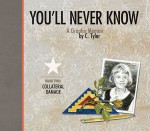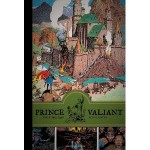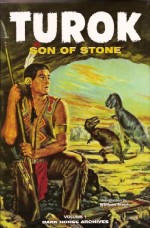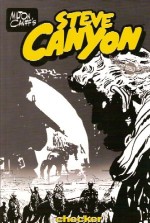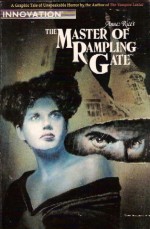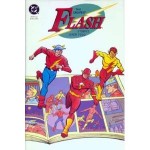
By various (DC Comics)
ISBN: 978-0-93028-981-2
When the very concept of high priced graphic novels was just being gradually accepted in the early 1990s DC comics produced a line of glorious hardback compilations that highlighted star characters and even celebrated the standout stories from the company’s illustrious and varied history decade by decade.
The Greatest Stories collections were revived in this century as smaller paperback editions (with mostly differing content) and stand as an impressive introduction to the fantastic worlds and exploits of the World’s Greatest Superheroes but for sheer satisfaction the older, larger books are by far the better product. Some of them made it to softcover trade paperback editions, but if you can afford it the big hard ones are the jobs to go for…
Since I believe reading comics to be a fully immersive experience (smell, feel, good coffee, biscuits, a solid soundtrack playing and somewhere someone futilely shouting to get your attention) I’ll be reviewing most of them over the up next few months but I’m starting with the volume dedicated to the hero attributed with starting the Silver Age and the other characters who share the sobriquet of “the Fastest Man Aliveâ€â€¦
Edited by Mike Gold and Brian Augustyn with contributions from Robert Greenberger, Katie Main and Dan Thorsland plus a foreword by artist and ex-publisher Carmine Infantino, this volume presents some genuinely intriguing choices featuring the first three men to dazzle generations of readers as The Flash.
From the Golden Age comes four fabulous exploits of Jay Garrick – a scientist exposed to “hard water fumes†which gave him super-speed and endurance, beginning with his very first appearance ‘The Fastest Man Alive’ from Flash Comics #1 (January 1940) by Gardner Fox & Harry Lampert, who speedily delivered an origin, a returning cast and a classic confrontation with sinister gang the Faultless Four and their diabolical leader Sieur Satan.
This is followed by ‘The Flash and the Black Widow’ from issue #66 (August 1945) written by budding horror-novelist Robert Bloch and illustrated by E.E. Hibbard wherein a seductive menace transformed helpless victims – including hapless comedy sidekicks Winky, Blinky and Noddy – into talking animals.
‘Stone Age Menace’ (Flash Comics #86, 1947) is a time travel caper scripted by Robert Kanigher and illustrated by Lee Elias whilst from December of that year the same team crafted a spectacular clash with criminal mastermind the Turtle, who tried once more to profit from ‘The Slow-Motion Crimes’.
As the 1950s dawned the popularity of costumed heroes dwindled and for nearly a decade licensed properties, Crime, Westerns, War, Mystery and other genre fare dominated the newsstands. Despite the odd bold sally, costumed heroes barely held their own until Julius Schwartz ushered in a new age of brightly clad mystery-men by reviving the Flash in 1956. For the great majority of fans (aging baby-boomers that we are) police scientist Barry Allen will always be the “real†Scarlet Speedster, struck by lightning, bathed in chemicals – if you couldn’t find an atomic blast to survive, that kind of freak accident was the only way to start a career.
From his spectacular run comes the pivotal event which marked the beginning of a way of life for so many addicted kids: ‘Mystery of the Human Thunderbolt!’ (Showcase #4), written by Kanigher, penciled by Infantino and inked by Joe Kubert, was another quick-fire origin with crime story attached as the brand new hero discovered his powers and mission and still found time to defeat a modern iteration of the Turtle.
John Broome and Gardner Fox would write the bulk of the early tales, introducing a “big science†sensibility and, courtesy of Broome, a Rogues Gallery of fantastic foes which would become the template for all proper superheroes. After four Showcase try-outs the Vizier of Velocity won his own title, picking up the numbering of Flash Comics which had folded in 1949 after 104 issues.
Such a one was Grodd, sole malcontent of a race of hyper-evolved simians who in Broome, Infantino & Joe Giella’s ‘Return of the Super-Gorilla’ (Flash #107, June 1959) lured the Scarlet Speedster to the centre of the Earth and a lost race of bird-men. Another was The Trickster, a prankster-bandit who could defy gravity. In his debut appearance ‘Danger in the Air!’ (Flash #1113, June 1960), Broome, Infantino & Giella provided the ideal counterpart to the rather stuffy hero whilst #119’s ‘The Mirror-Master’s Magic Bullet’ (March 1967 and inked by Murphy Anderson) showed the hero’s wits were always faster than any speed his feet could attain.
Ductile Detective Elongated Man began as a Flash cameo and his subsequent guest-shots were always a benchmark for offbeat thrills. In #124 (November 1961, inked by Giella) Captain Boomerang’s ‘Space Boomerang Trap’ led to an extra-dimensional invasion and an uneasy alliance of heroes and villain whereas next issue’s epic ‘The Conquerors of Time!’ was a mind-boggling classic as time-travelling aliens attempted to subjugate Earth in 2287AD by preventing fissionable elements from forming in 100,842,246BC. Antediluvian lost races, another pivotal role for Kid Flash Wally West (easily the most trusted and responsible sidekick of the Silver Age), the introduction of the insanely cool Cosmic Treadmill plus spectacular action make this a benchmark of quality graphic narrative.
‘Flash of Two Worlds’ (not included here so see either Showcase Presents the Flash volume 2 or the aforementioned Flash: the Greatest Stories Ever Told 2007 tpb) revived the Golden Age Flash, and by implication, the whole 1940s DC pantheon, by introducing the concept of parallel worlds and multiple Earths which became the bedrock of the entire continuity, and which the company still mines to such great effect.
What is included here is ‘Vengeance of the Immortal Villain!’ from Flash #137 (June 1963, written by Fox and inked by Giella) the third chronological Earth-2 crossover, which saw two Flashes unite to defeat 50,000 year old Vandal Savage and save the Justice Society of America: a tale which directly led into the veteran team’s first meeting with the Justice League of America and the start of all those beloved “Crisis†epics.
Barry Allen’s best friend was test pilot Hal Jordan who fought crime as an agent of the Guardians of the Universe, so the heroes joined forces on a regular basis. From Flash #143, March 1964 comes the intriguing high-tech mystery ‘Trail of the False Green Lanterns!’ by John Broome, Infantino and Giella, who also produced the award-winning and deeply moving ghost-story ‘The Doorway to the Unknown!’ (#148, November 1964).
Cary Bates became the Flash’s regular – and exclusive – writer from the early 1970s to the hero’s demise in 1985, but he was only a promising newcomer when he co-scripted with Fox the exuberant fourth-wall busting epic ‘The Flash – Fact or Fiction?’(#179, May 1968, illustrated by Ross Andru & Mike Esposito) which took the multiple Earths concept to its logical conclusion by trapping the Monarch of Motion in “our†Reality, where the Flash was just a comic-book character! However Bate’s slick solo effort ‘How to Prevent a Flash’ (Five-Star Super-Hero Spectacular 1977), illustrated by Irv Novick & Frank McLaughlin shows a mature subtlety that highlights not just superpowers but the hero’s forensic thinking…
Barry Allen died during the Crisis on Infinite Earths – and stayed dead for what is now a very long time in comics. In the years leading up to that he endured a monolithic saga wherein his wife was murdered, he destroyed her killer and was ultimately brought to trial for manslaughter. That saga, encompassing #275-350, is condensed here into ‘The Final Flash Storyline’ – a handy text feature by Bates with illustrations from Infantino, Dennis Jensen, Gary Martin, Frank McLaughlin, George Pérez & Jerry Ordway.
In honour of his ultimate sacrifice, Barry’s nephew Wally West graduated from sidekick to the third Sultan of Speed and carved his own legend in scarlet and gold. This terrific tome concludes with a Reagan-era classic as the severely outclassed new hero battled Vandal Savage in the gripping ‘Hearts… of Stone’ (Flash volume 2, #2 July 1987 by Mike Baron, Jackson Guice & Larry Mahlstedt) to close the book.
Not quite the icon Superman, Batman or Wonder Woman are, Flash is nevertheless the quintessential superhero and the reason we’re all doing this today. This delightful book is a superb example of superhero stories at their very best and whatever your age or temperament there’s something great here for you to enjoy and treasure.
© 1940-1987, 1991 DC Comics. All rights reserved.




